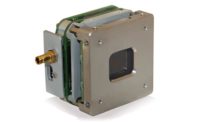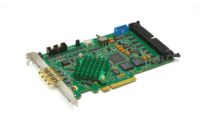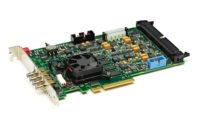Over the last four decades the demand for quality in manufacturing has dramatically increased. No longer do consumers accept minute scratches on a new car, computer, furniture or bicycle. For manufacturers, the challenge has been to meet consumers’ rising standards in the most cost-effective, reliable manner.
It wasn’t always this way. Until the 1970s, the typical final inspection of a product was conducted at the end of a production line where it was given a “once over” visual check. If defects were found a decision was made either to rework the product or simply ship it as is. In order to avoid costly waste or rework time a good number of inferior products entered the marketplace. However, consumers at the time were more forgiving, having learned early on to accept that nothing is perfect in this world.
TECH TIPSIn 2009 a new interface was introduced to achieve faster speeds: CoaXPress, an interface using coaxial cabling to transfer data at speeds of up to 625 MB/S per cable. It also allows the option to use up to four links for a total of 2.5 GB/S of data transfer rates. This new speed has turned the industry on its head. Sensors, cameras and frame grabbers of this new interface are seeing a growth in popularity because of the capabilities of a system with all this data. |
The demand for better quality
In the 1970s and 80s, as companies became more competitive and global, any marketing edge was used to bring the consumer onto their side. Sometimes it was price, but then, in many cases, you “got what you paid for”—a cheaply manufactured product with a minimal lifespan. Quality became a rallying cry as manufacturers came to realize that consumers would pay significantly more for their products if they recognized them as reliable and consistent.
It was during this time period that manufacturers began to deploy in-line assessments on their production lines conducted by the “quality inspector” who examined random items visually for defects. While this helped reduce waste at the end of the line, there was still a missing factor: machine vision. For purpose of illustration, consider a Friday afternoon or a Monday morning when the quality inspector is simply too tired or distracted to be effective at the job. Some defects inevitably slip through, damaging the company’s reputation and angering customers.
Of course, there are also limitations to human vision due to the brightness, speed, and distance of the object being examined. This is when machine vision for quality control first came to be seen as a benefit. And while there was a common misconception at the time that still lingers today that machine vision replaced human jobs, the reality is just the opposite. Because machine vision enhanced overall product quality, it enabled each company utilizing it to sell more products at higher profits margins, ultimately requiring the company to expand its workforce.
Machine Vision for Quality Control
Broken down to its simplest form, machine vision for quality control is the process of acquiring an image of an object, and analyzing it for defects of any sort, whether it is shape, text, color or scratches. Let’s use a cell phone as an example: When the first commercial cell phones appeared in the early ‘80s few customers cared about screen resolution or a minor scratch on the casing. However, as technology progressed, consumers became more attentive of phone quality. Today screen resolution is a major factor in the buying criteria, as we tend to play games and watch movies on our phones. Phones are also now considered fashion accessories, so a visible scratch or discoloration is no longer acceptable.
The demand for quality shows no signs of diminishing. Where once a scratch of one millimeter was acceptable, the electronics industry today touts surfaces with no blemishes more than a few microns. Advances in machine vision have enabled these micro-defects to be observed and captured.
Faster Technology – Sensors, Cameras and Computers
Over the last 15 years, camera sensors have become larger and faster. Because of this it is possible to take higher resolution images at very high speeds. Where once the only option for a machine vision system was an analog camera imaging 640 x 480 pixels at 30 frames per second (fps), we now see cameras on the market where image size is 4080 x 3072 at 167 fps. This means a data rate of 9.2 MB/S has being replaced by a potential data rate of almost 2.1 GB/S—a multiplier of several orders of magnitude. Higher speed or higher resolution translates into a product being manufactured faster with fewer defects. The end result is a lower cost of manufacturing that, if passed onto the consumer, can result in higher sales and the prompt growth in a company.
More data traveling at higher speeds has required more computer power to sort out the good from the bad. If the camera sensor is larger, then the method of transferring the data to the host computer has to be faster, and the method of analyzing the data has to be quicker as well.
All of this brings us to the frame grabber. Yes, computers today are more powerful than ever before, capable of crunching huge amounts of data and coming to a “go” or “no go” decision within hundredths of a second. But in order to transfer acquired data from the camera’s sensor to the computer the system developer must integrate a high-end frame grabber. Once upon a time, frame grabbers were the predominate method of getting data from a camera into a computer, using the PCI slot or one of its predecessors. With the advent of GigE vision, USB, Firewire and their similar interfaces many industry insiders predicted the death of the frame grabber. But alas, while the frame grabber has been on the tech deathwatch list for several years, it has reinvented itself every time in order to become even more indispensable to the high technology industry as new interface standards have emerged every decade or so including the recent introduction of CoaXPress interface. And despite the new digital interfaces, analog cameras still have a strong position in the vision industry. Camera manufacturers are selling lots of analog units to OEMs who continue to recognize that analog cameras work well, are understood by their engineers and are very cost-effective.
Limitations of a non-frame grabber solution
Looking at the camera numbers above, you can see that the non-frame grabber interfaces can offer data rates of up to 482 MB/S. But for certain technologies that require the ultimate in resolution for the best quality the non-frame grabber solution for quality control is not sufficient. For example, companies producing flat panels or semiconductors where microns are critical will use the frame grabbers and camera solution. The strengths of frame grabbers are found in applications with multiple cameras, high bandwidth and integral pre-processing. Ethernet and USB are not designed for this high-bandwidth, latency-free transfer.
Camera Link Interface
One of the most common camera to computer interface standards for frame grabbers is Camera Link which has been around since 2001. Today, most camera manufacturers have a Camera Link camera available as part of their overall portfolio. Going back to the numbers there are three types of CL speeds: CL Base (255MB/S), CL Medium (510 MB/S) and CL Full (680 MB/S). As camera sensors became larger and faster a new option emerged called Camera Link 80-bit, or 10-tap format. This is a speed of 850 MB/S that is the highest rate that Camera Link can reach. For system developers, the design rule of thumb was: Camera Link for high speeds and short distances and GigE Vision for lower speeds (100MB/s) at long distances. However, with an upper data rate limitation of only 850 MB/S, something different was needed.
CoaXPress Interface
In 2009 a new interface was introduced to achieve faster speeds: CoaXPress, an interface using coaxial cabling to transfer data at speeds of up to 625 MB/S per cable, known as a “link” with the option to use up to four links for a total of 2.5 GB/S of data transfer rates. This new speed has turned the industry on its head. Sensors, cameras and frame grabbers of this new interface are seeing a growth in popularity because of the capabilities of a system with all this data.
In 2010 the CXP standard was ratified by Japanese Industrial Imaging Association (JIIA) and following the three month appeals process, became a world standard in March 2011 when it was given support by the Automated Imaging Association (AIA) and the European Machine Vision Association (EMVA) under the G3 agreement of 2009. The current release is 1.1 (February 2013) and as of last December (2013), there were over 25 different manufacturers offering some type of CoaXPress related product.
The frame grabbers that first emerged for CoaXPress were equipped with BNC connectors leading some industry outsiders to believe that analog was making a comeback, but that was not the case. The BNC connector is capable of handling up to 6.25Gb/S of data transfer while at the same time allowing up to 20MB/S of data and up to 13W of power to be sent from the frame grabber to the camera. There is now an opportunity for even faster speeds but a different connector is needed to handle the higher speeds. This connector is the DIN1.0/2.3 connector. Some of the manufacturers are prepared for the future, speeds of up to 12Gb/S per link are realistic in the next one to two years and speeds of 10Gb/S per link have already been observed. On the sensor side the 12MP sensor previously mentioned is now capable of up to 300 FPS (3.6Gb/S). Some manufacturers saw this emergence of faster speeds and made their products accordingly. Some even offer the option of the high-speed uplink on a separate DIN1.0/2.3 connector eliminating the 20MB/S limitations.
While there are other methods of data transfer at high speeds, it seems the machine vision industry worldwide has adopted CXP as the ultimate standard. Like Camera Link it too may be surpassed in time, but for now, it’s the gold standard of large volume high-speed data transfer.





